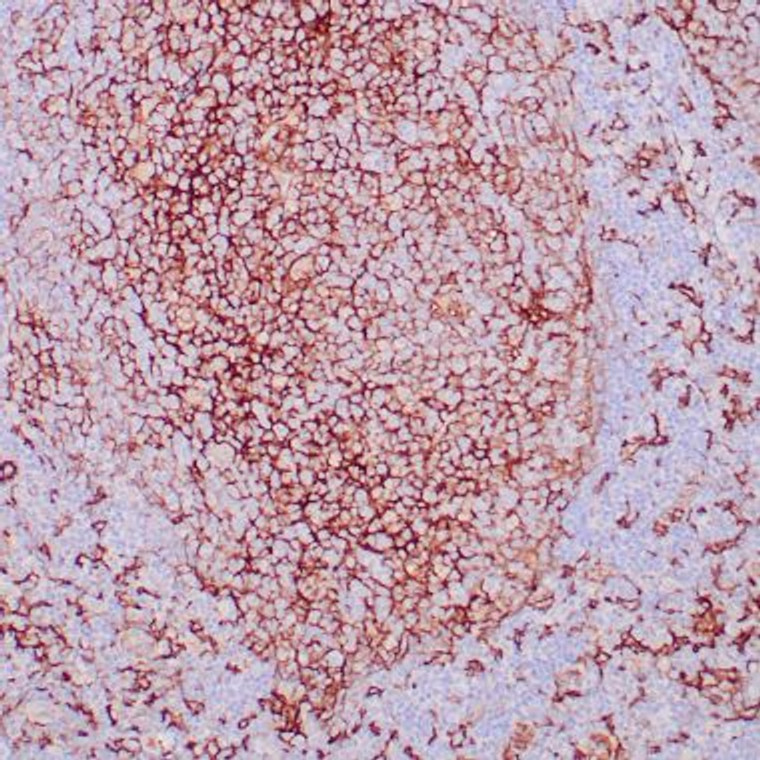| Host: |
Mouse |
| Applications: |
IHC-P |
| Reactivity: |
Human |
| Note: |
STRICTLY FOR FURTHER SCIENTIFIC RESEARCH USE ONLY (RUO). MUST NOT TO BE USED IN DIAGNOSTIC OR THERAPEUTIC APPLICATIONS. |
| Short Description: |
Mouse monoclonal antibody anti-CD14 (25-148aa) is suitable for use in Immunohistochemistry research applications. |
| Clonality: |
Monoclonal |
| Clone ID: |
ZM104 |
| Conjugation: |
Unconjugated |
| Isotype: |
IgG1/Kappa |
| Formulation: |
Tris-HCI buffer containing stabilizing protein (BSA) and <0.1% ProClin |
| Purification: |
Affinity purified |
| Dilution Range: |
1:100-200 |
| Storage Instruction: |
Store at 2‐8°C for up to 24 months. Predilute: Ready to use, no reconstitution necessary. Concentrate: Use dilution range and appropriate lab‐standardized diluent. Stability after dilution: 7 days at 24°C, 3 months at 2‐8°C, 6months at ‐20°C. |
| Gene Symbol: |
CD14 |
| Gene ID: |
929 |
| Uniprot ID: |
CD14_HUMAN |
| Immunogen Region: |
25-148aa |
| Specificity: |
Positive control: Tonsil or lymph node |
| Immunogen: |
Recombinant fragment of human CD14 protein (around aa 25-148) |
| Tissue Specificity | Detected on macrophages (at protein level). Expressed strongly on the surface of monocytes and weakly on the surface of granulocytes.also expressed by most tissue macrophages. |
| Post Translational Modifications | N- and O- glycosylated. O-glycosylated with a core 1 or possibly core 8 glycan. |
| Function | Coreceptor for bacterial lipopolysaccharide. In concert with LBP, binds to monomeric lipopolysaccharide and delivers it to the LY96/TLR4 complex, thereby mediating the innate immune response to bacterial lipopolysaccharide (LPS). Acts via MyD88, TIRAP and TRAF6, leading to NF-kappa-B activation, cytokine secretion and the inflammatory response. Acts as a coreceptor for TLR2:TLR6 heterodimer in response to diacylated lipopeptides and for TLR2:TLR1 heterodimer in response to triacylated lipopeptides, these clusters trigger signaling from the cell surface and subsequently are targeted to the Golgi in a lipid-raft dependent pathway. Binds electronegative LDL (LDL(-)) and mediates the cytokine release induced by LDL(-). |
| Protein Name | Monocyte Differentiation Antigen Cd14Myeloid Cell-Specific Leucine-Rich GlycoproteinCd Antigen Cd14 Cleaved Into - Monocyte Differentiation Antigen Cd14 - Urinary Form - Monocyte Differentiation Antigen Cd14 - Membrane-Bound Form |
| Database Links | Reactome: R-HSA-1236974Reactome: R-HSA-140534Reactome: R-HSA-166016Reactome: R-HSA-166020Reactome: R-HSA-166058Reactome: R-HSA-166166Reactome: R-HSA-168179Reactome: R-HSA-168188Reactome: R-HSA-2562578Reactome: R-HSA-5602498Reactome: R-HSA-5603041Reactome: R-HSA-5686938Reactome: R-HSA-6798695Reactome: R-HSA-936964Reactome: R-HSA-937041Reactome: R-HSA-937072Reactome: R-HSA-975163 |
| Cellular Localisation | Cell MembraneLipid-AnchorGpi-AnchorSecretedMembrane RaftGolgi ApparatusSecreted Forms May Arise By Cleavage Of The Gpi Anchor |
| Alternative Antibody Names | Anti-Monocyte Differentiation Antigen Cd14 antibodyAnti-Myeloid Cell-Specific Leucine-Rich Glycoprotein antibodyAnti-Cd Antigen Cd14 Cleaved Into - Monocyte Differentiation Antigen Cd14 - Urinary Form - Monocyte Differentiation Antigen Cd14 - Membrane-Bound Form antibodyAnti-CD14 antibody |
Information sourced from Uniprot.org
12 months for antibodies. 6 months for ELISA Kits. Please see website T&Cs for further guidance







